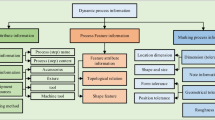Abstract
The problems of computer simulation of the continuous tube rolling on FQM (fine quality mill) are formulated and solved to study the influence of technological factors on the shape change and the danger of metal fracture. The solution of the problems makes it possible to estimate the effect of the deviation of the rolling axes of the continuous mill and the extraction mill. The simulation results allowed us to formulate and propose technical solutions to minimize the probability of risk defect formation.





Similar content being viewed by others
REFERENCES
V. A. Toporov, V. L. Pyatkov, and B. G. P’yankov, “Introduction of a pipe-rolling plant with a continuous FQM mill at the Seversk pipe plant,” in Proceedings of the XXII International Conference on Innovations and Import Substitution in the Pipe Industry (Pipes-2016), Ed. by I. Yu. Pyshmintsev (2016), pp. 16–19.
N. Teelen, P. Rinal’di, D. Milaneze, et al., “PQF technology for the production of seamless steel pipes,” Chernye Metally, No. 4, 47–52 (2005).
E. A. Shkuratov and A. V. Vydrin, “Improvement of the technology for hollow shell longitudinal rolling in continuous rolling mills,” Chernye Metally, No. 3, 42–46 (2017).
M. D. Alyutin and V. V. Shirokov, “Push benches and prospects of their application,” Metallurgist 62 (9–10), 1062–1067 (2019).
N. A. Glazunova, O. V. Rozhkova, and I. A. Kovaleva, “Classification according to a guide scratch defect on the inner surface of hot-rolled pipes,” Lit’e Metallurgiya, No. 1 (74), 28–32 (2014).
V. A. Pravosudovich, V. P. Sokurenko, V. N. Danchenko, et al., Defects of Steel Ingots and Rolled Products: A Handbook (Intermet Inzhiniring, Moscow 2006).
N. N. Vavilkin and A. V. Krasikov, “Investigation of the deformation and kinematic parameters of pipe rolling on a continuous mill,” Izv. Vyssh. Uchebn. Zaved., Chern. Metall., No. 11, 22–25 (2009).
E. A. Shkuratov, B. G. P’yankov, R. O. Bushin, O. A. Panasenko, et al., “Determination of the technological axis of a continuous pipe rolling mill with three-high passes,” in Proceedings of the XXII International Conference on Innovations and Import Substitution in the Pipe Industry (Pipes-2016), Ed. by I. Yu. Pyshmintsev (2016), pp. 206–210.
O. A. Panasenko, E. A. Shkuratov, O. I. Belov, et al., “Improvement of the axial adjustment of the FQM mill equipment using noncontact 3D measuring systems,” Metallurg, No. 7, 26–29 (2019).
Technological Instruction STZ 004-024-2019. Seamless Pipe Rolling in the FQM Continuous Mill Line (Polevskoi, 2016).
J. Yu. Shi, E. Dong, and J. Wang, “Finite element simulation for hot continuous-rolled TC4 alloy seamless pipe,” in Lecture Notes in Mechanical Engineering (2018), pp. 705–716.
V. Ya. Osadchii and A. P. Kolikov, Production and Quality of Steel Pipes: Textbook for Universities, Ed. by V. Ya. Osadchii (Izd. MGUPI, Moscow, 2012).
A. P. Kolikov and B. A. Romantsev, Theory of Metal Forming (Izd. Dom MISiS, Moscow, 2015).
N. G. Kolbasnikov, V. V. Mishin, I. A. Shishov, M. A. Matveev, and A. M. Korchagin, “Surface-crack formation in the manufacture of microalloyed steel pipe,” Steel in Translation 46 (9), 665–670 (2016).
Author information
Authors and Affiliations
Corresponding author
Additional information
Translated by K. Shakhlevich
Rights and permissions
About this article
Cite this article
Toporov, V.A., Ibragimov, P.A., Panasenko, O.A. et al. Mathematical Model for Continuous Tube Rolling and the Effect of Technological Factors on Surface Defect Formation. Russ. Metall. 2020, 1632–1636 (2020). https://doi.org/10.1134/S0036029520130376
Received:
Revised:
Accepted:
Published:
Issue Date:
DOI: https://doi.org/10.1134/S0036029520130376




